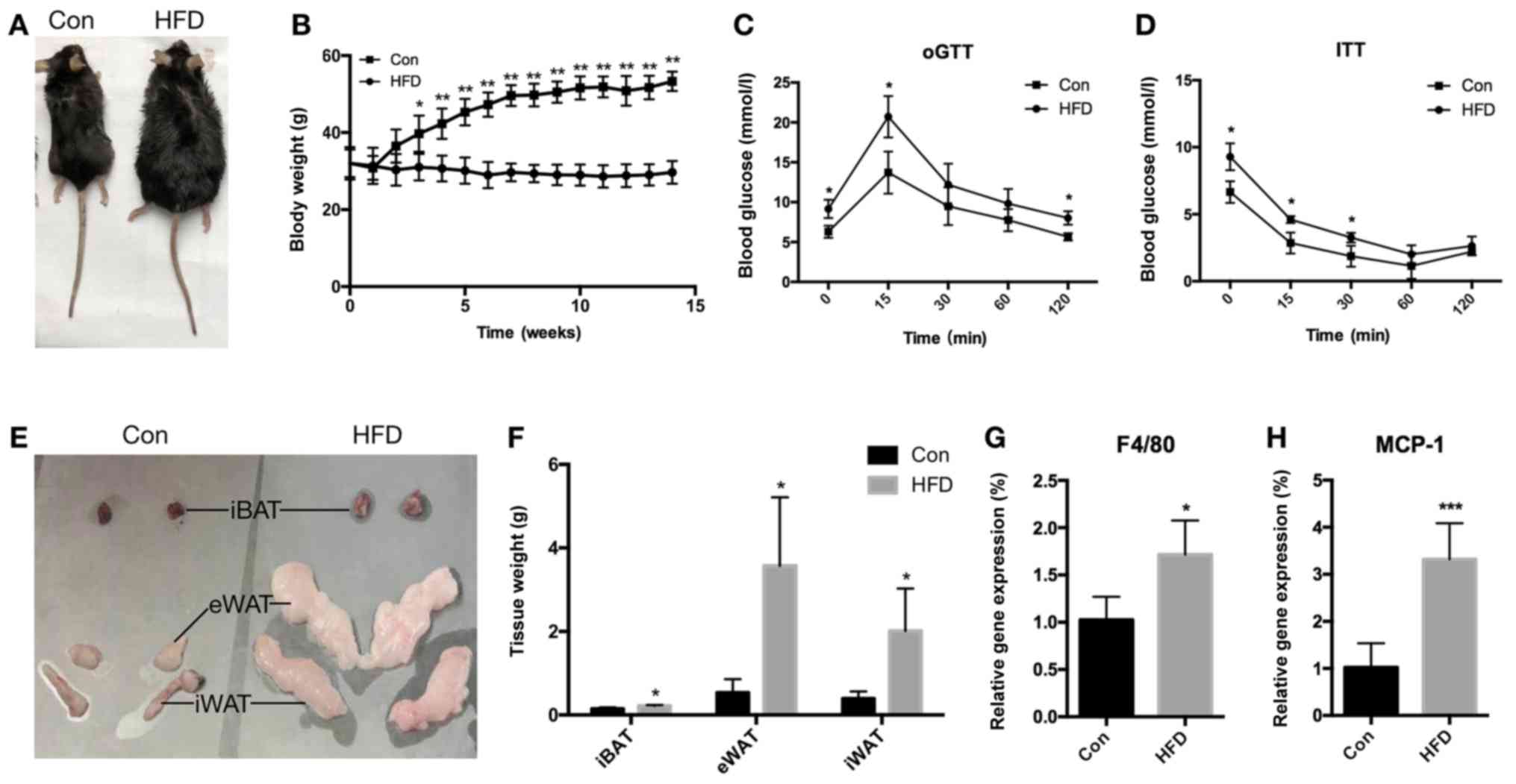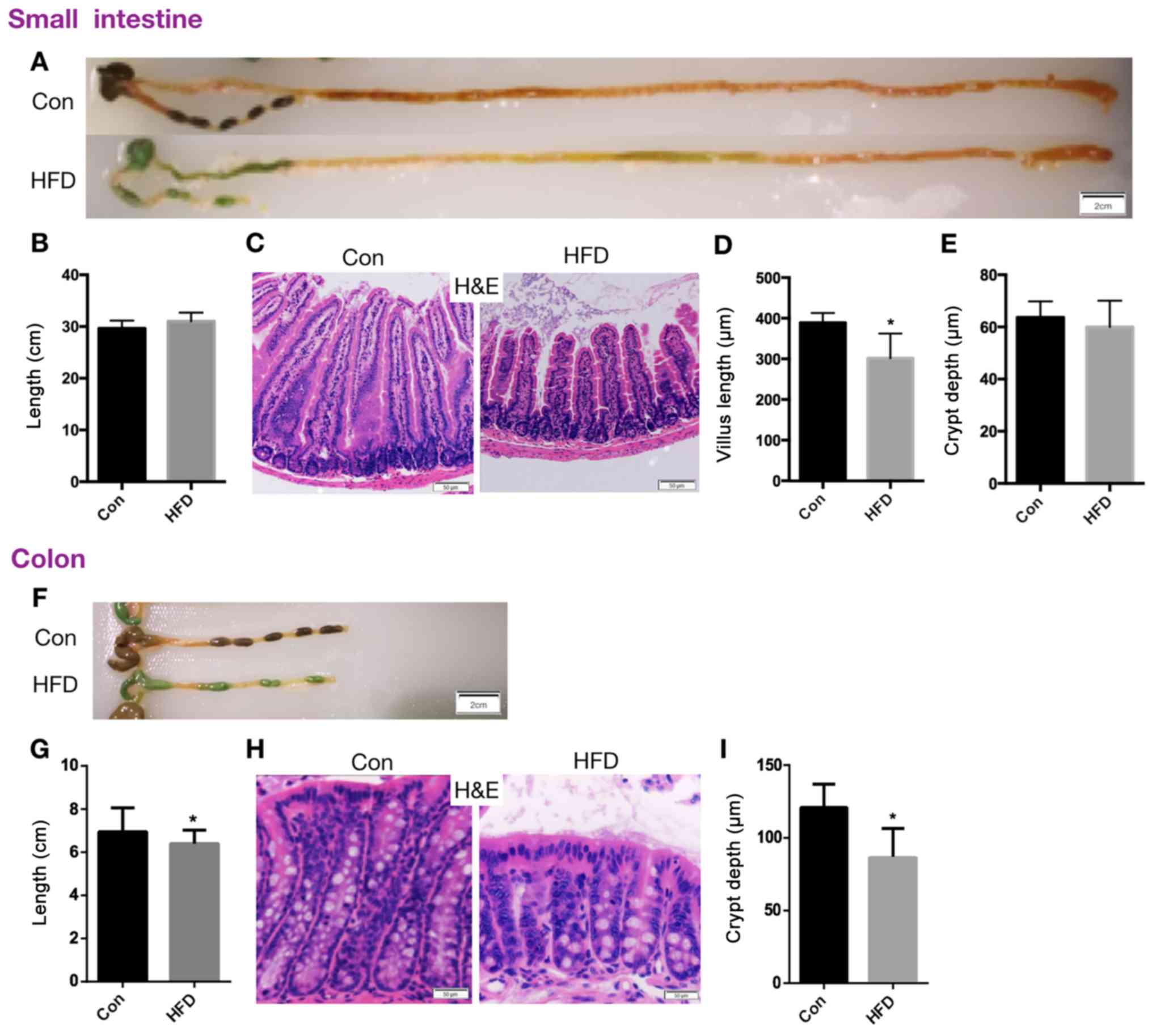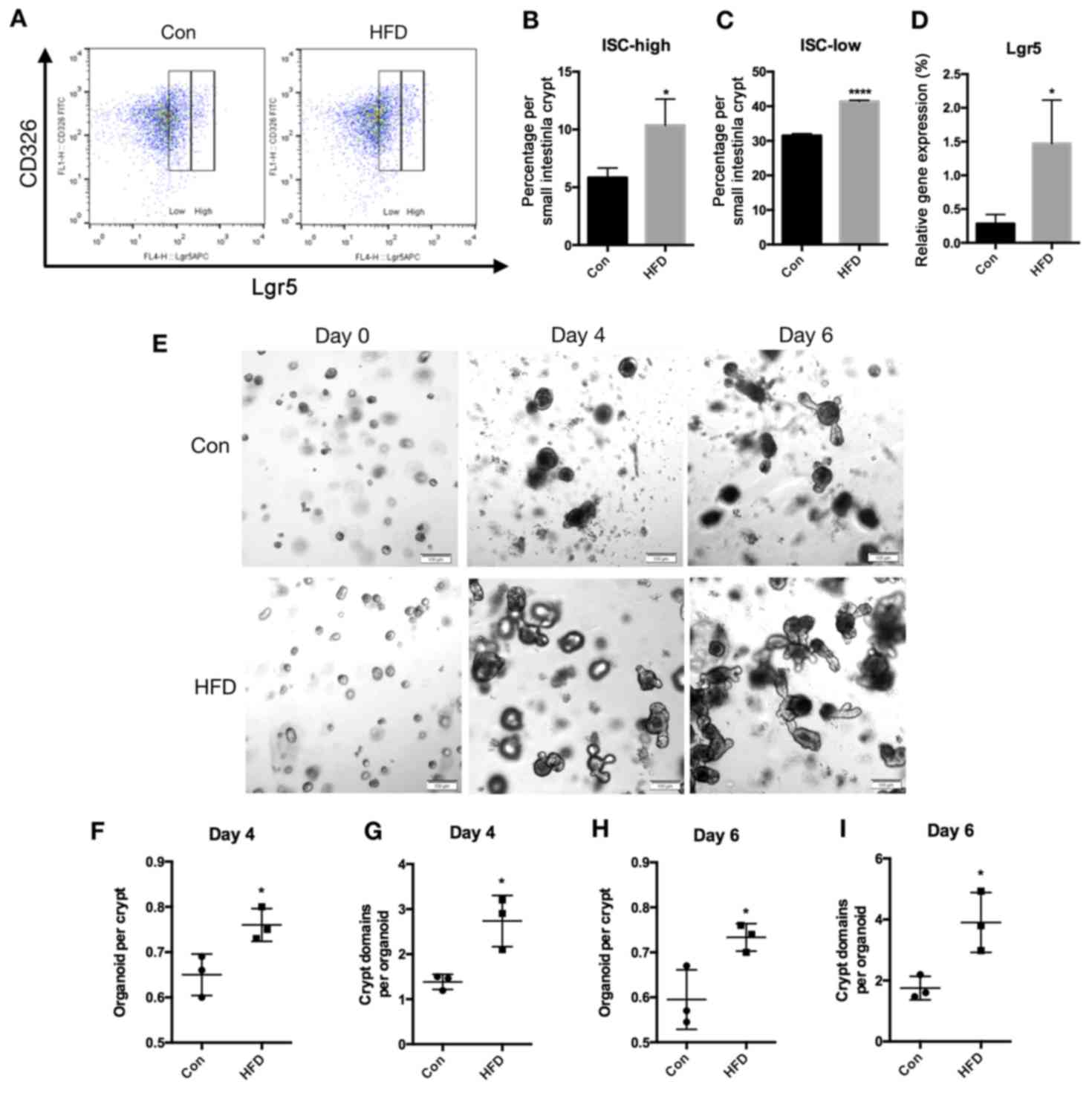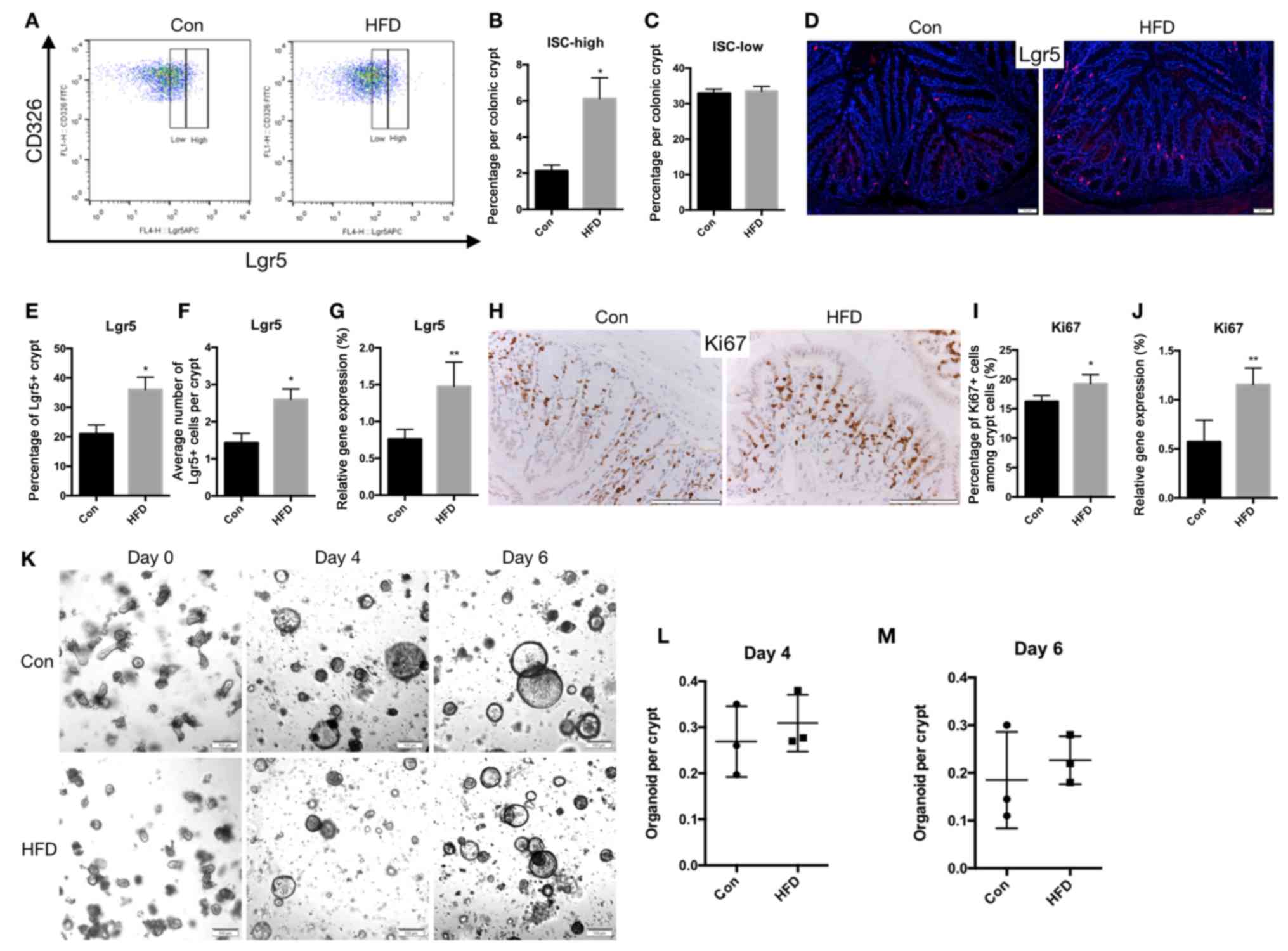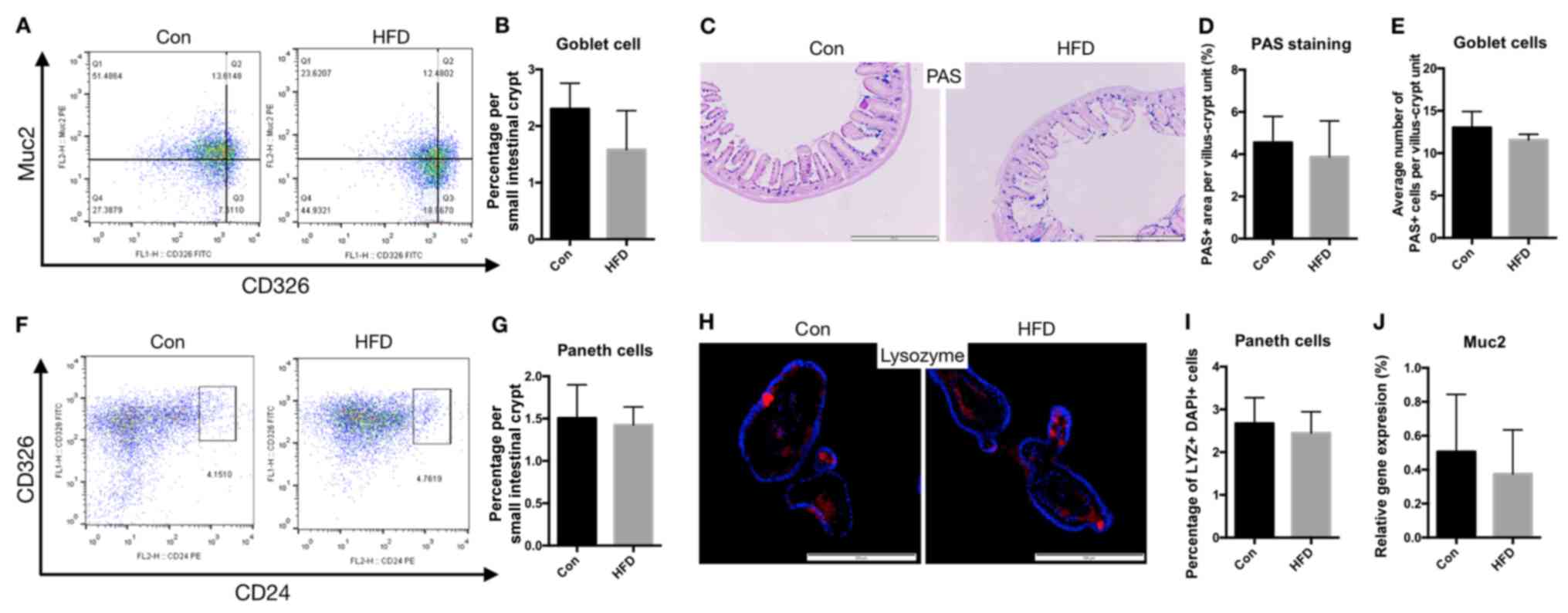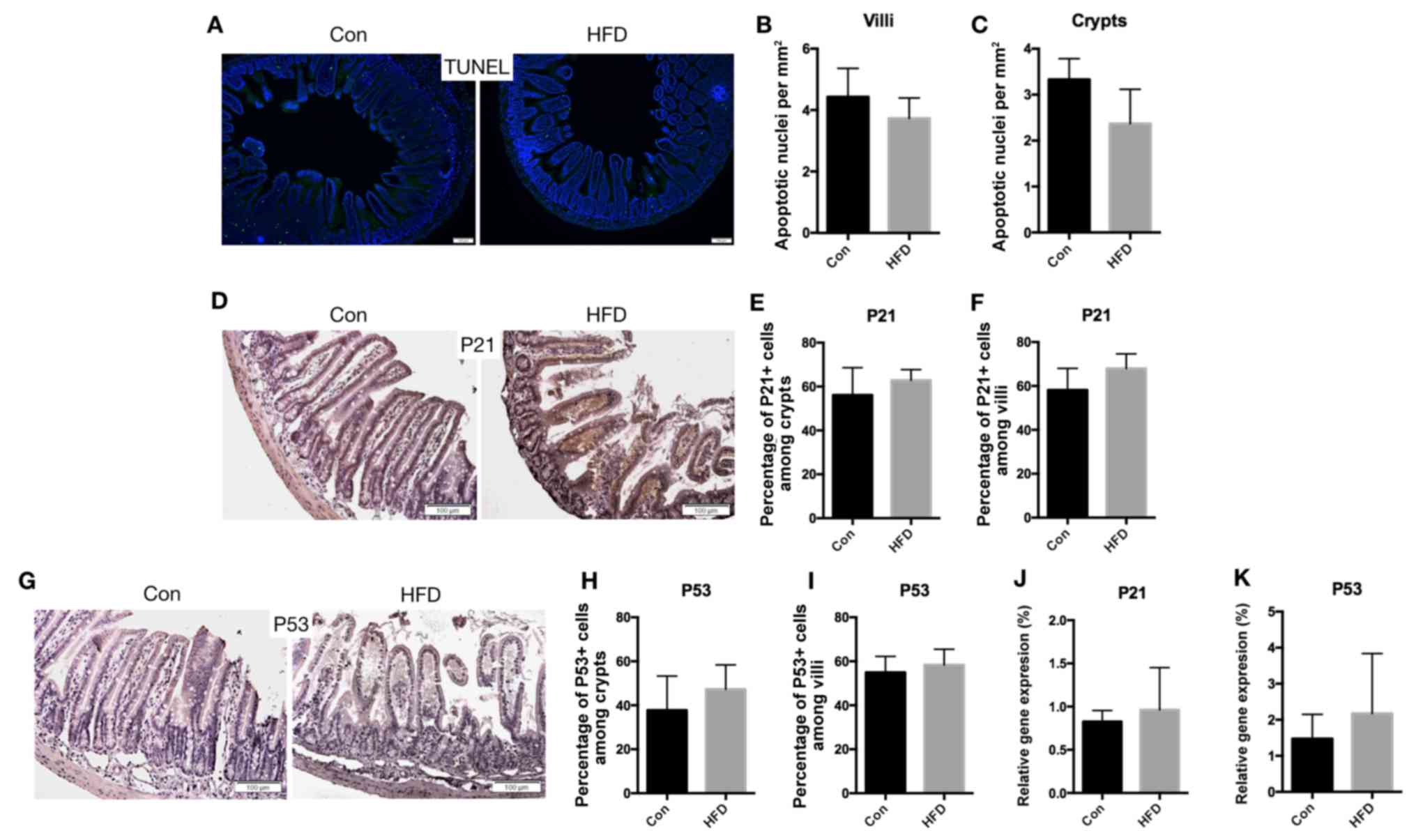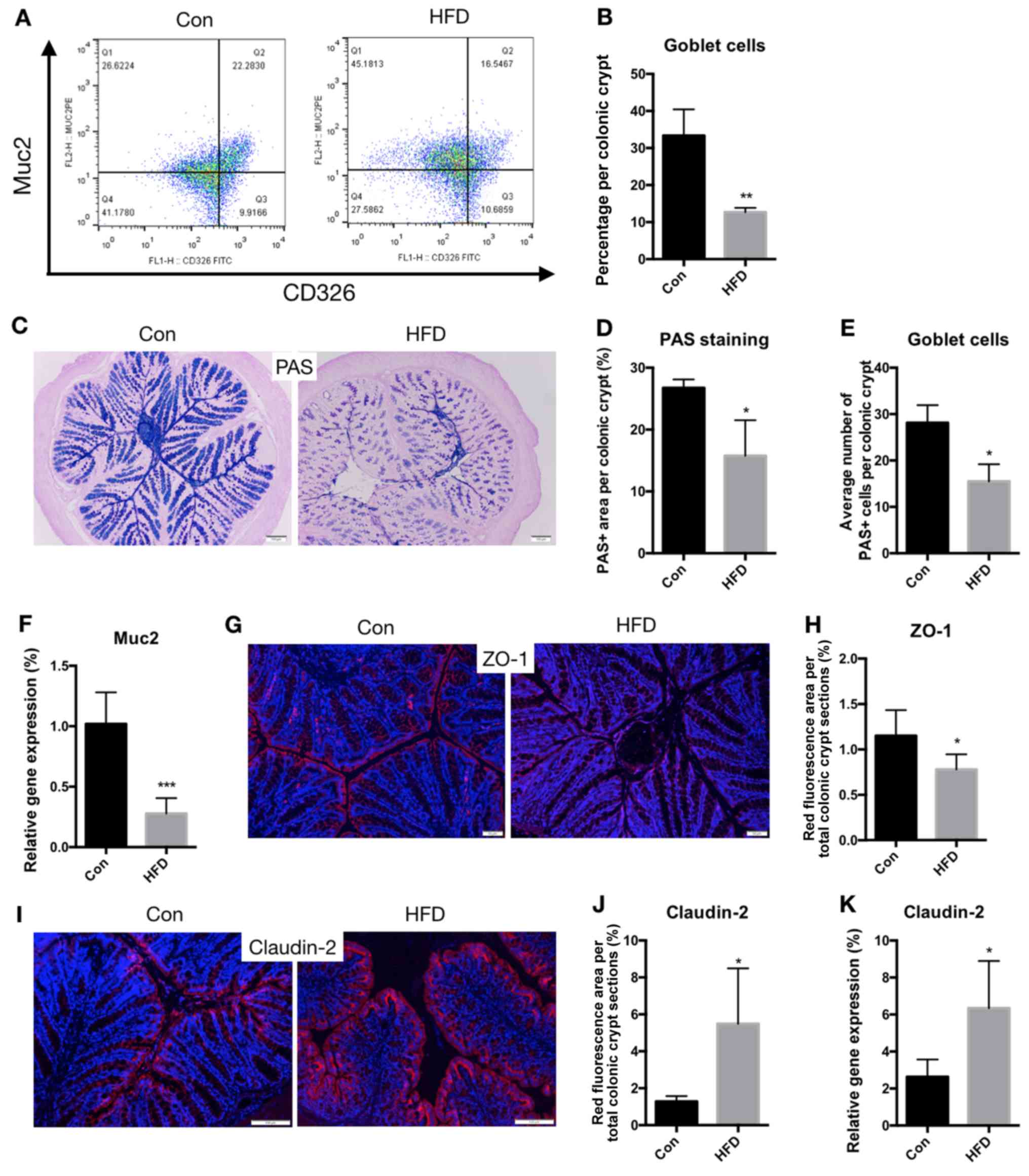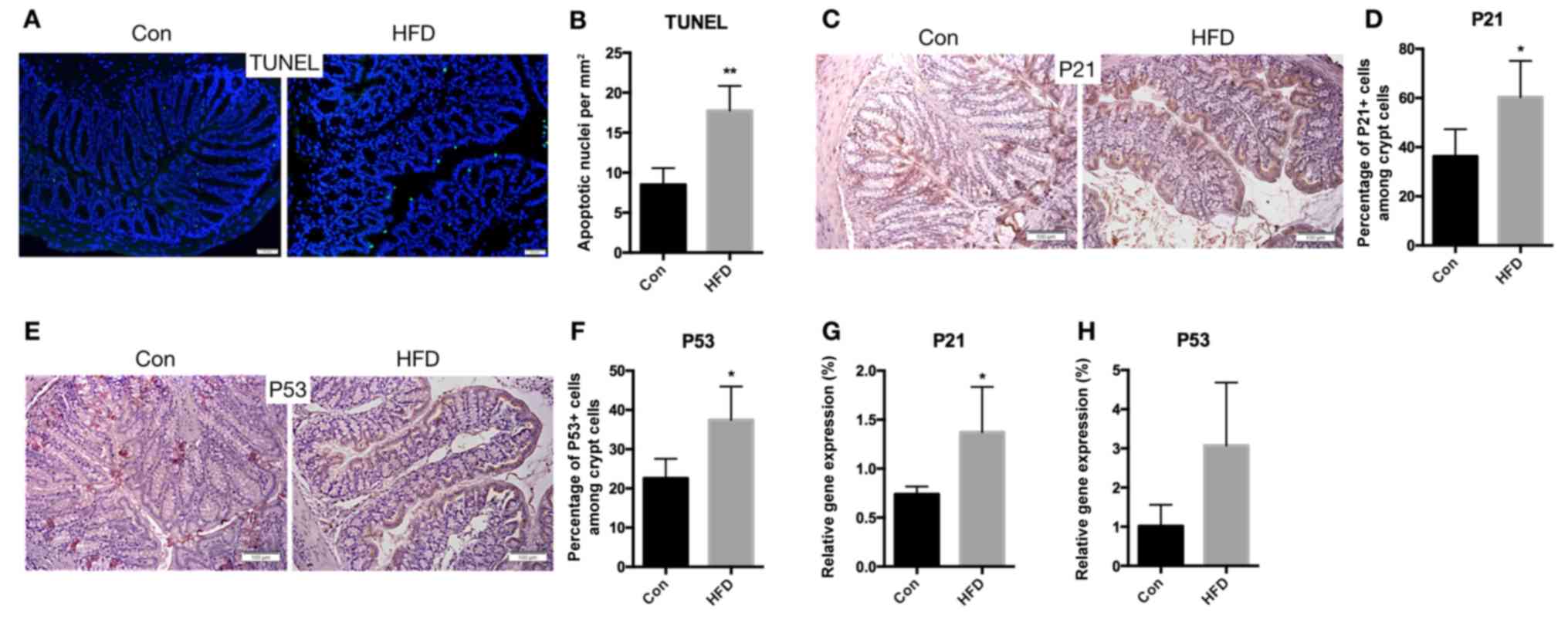|
1
|
Nagao M, Asai A, Sugihara H and Oikawa S:
Fat intake and the development of type 2 diabetes. Endocr J.
62:561–572. 2015. View Article : Google Scholar : PubMed/NCBI
|
|
2
|
Schulz MD, Atay C, Heringer J, Romrig FK,
Schwitalla S, Aydin B, Ziegler PK, Varga J, Reindl W, Pommerenke C,
et al: High-fat-diet-mediated dysbiosis promotes intestinal
carcinogenesis independently of obesity. Nature. 514:508–512. 2014.
View Article : Google Scholar : PubMed/NCBI
|
|
3
|
Bleau C, Karelis AD, St-Pierre DH and
Lamontagne L: Crosstalk between intestinal microbiota, adipose
tissue and skeletal muscle as an early event in systemic low-grade
inflammation and the development of obesity and diabetes. Diabetes
Metab Res Rev. 31:545–561. 2015. View Article : Google Scholar : PubMed/NCBI
|
|
4
|
David LA, Maurice CF, Carmody RN,
Gootenberg DB, Button JE, Wolfe BE, Ling AV, Devlin AS, Varma Y,
Fischbach MA, et al: Diet rapidly and reproducibly alters the human
gut microbiome. Nature. 505:559–563. 2014. View Article : Google Scholar : PubMed/NCBI
|
|
5
|
Wu GD, Chen J, Hoffmann C, Bittinger K,
Chen YY, Keilbaugh SA, Bewtra M, Knights D, Walters WA, Knight R,
et al: Linking long-term dietary patterns with gut microbial
enterotypes. Science. 334:105–108. 2011. View Article : Google Scholar : PubMed/NCBI
|
|
6
|
Backhed F, Ley RE, Sonnenburg JL, Peterson
DA and Gordon JI: Host-bacterial mutualism in the human intestine.
Science. 307:1915–1920. 2005. View Article : Google Scholar : PubMed/NCBI
|
|
7
|
Qin N, Yang F, Li A, Prifti E, Chen Y,
Shao L, Guo J, Le Chatelier E, Yao J, Wu L, et al: Alterations of
the human gut microbiome in liver cirrhosis. Nature. 513:59–64.
2014. View Article : Google Scholar : PubMed/NCBI
|
|
8
|
Carmody RN, Gerber GK, Luevano JM Jr,
Gatti DM, Somes L, Svenson KL and Turnbaugh PJ: Diet dominates host
genotype in shaping the murine gut microbiota. Cell Host Microbe.
17:72–84. 2015. View Article : Google Scholar : PubMed/NCBI
|
|
9
|
Kurashima Y, Goto Y and Kiyono H: Mucosal
innate immune cells regulate both gut homeostasis and intestinal
inflammation. Eur J Immunol. 43:3108–3115. 2013. View Article : Google Scholar : PubMed/NCBI
|
|
10
|
Bjerregaard LG, Jensen BW, Angquist L,
Osler M, Sorensen TIA and Baker JL: Change in overweight from
childhood to early adulthood and risk of type 2 diabetes. N Engl J
Med. 378:1302–1312. 2018. View Article : Google Scholar : PubMed/NCBI
|
|
11
|
Feldman AT and Wolfe D: Tissue processing
and hematoxylin and eosin staining. Methods Mol Biol. 1180:31–43.
2014. View Article : Google Scholar : PubMed/NCBI
|
|
12
|
Dame MK and Varani J: Human colon tissue
in organ culture. Replacing animal models. Davies J: John Wiley
& Sons, Inc.; Hoboken, NJ: pp. 69–80. 2012, View Article : Google Scholar
|
|
13
|
Sato T and Clevers H: Primary mouse small
intestinal epithelial cell cultures. Methods Mol Biol. 945:319–328.
2013. View Article : Google Scholar : PubMed/NCBI
|
|
14
|
Sato T, Vries RG, Snippert HJ, van de
Wetering M, Barker N, Stange DE, van Es JH, Abo A, Kujala P, Peters
PJ and Clevers H: Single Lgr5 stem cells build crypt-villus
structures in vitro without a mesenchymal niche. Nature.
459:262–265. 2009. View Article : Google Scholar : PubMed/NCBI
|
|
15
|
Date S and Sato T: Mini-gut organoids:
Reconstitution of the stem cell niche. Annu Rev Cell Dev Biol.
31:269–289. 2015. View Article : Google Scholar : PubMed/NCBI
|
|
16
|
Koo BK, Sasselli V and Clevers H:
Retroviral gene expression control in primary organoid cultures.
Curr Protoc Stem Cell Biol. 27:Unit 5A.6. 2013. View Article : Google Scholar : PubMed/NCBI
|
|
17
|
Sato T, van Es JH, Snippert HJ, Stange DE,
Vries RG, van den Born M, Barker N, Shroyer NF, van de Wetering M
and Clevers H: Paneth cells constitute the niche for Lgr5 stem
cells in intestinal crypts. Nature. 469:415–418. 2011. View Article : Google Scholar : PubMed/NCBI
|
|
18
|
Beyaz S, Mana MD, Roper J, Kedrin D,
Saadatpour A, Hong SJ, Bauer-Rowe KE, Xifaras ME, Akkad A, Arias E,
et al: High-fat diet enhances stemness and tumorigenicity of
intestinal progenitors. Nature. 531:53–58. 2016. View Article : Google Scholar : PubMed/NCBI
|
|
19
|
Livak KJ and Schmittgen TD: Analysis of
relative gene expression data using real-time quantitative PCR and
the 2(-Delta Delta C(T)) method. Methods. 25:402–408. 2001.
View Article : Google Scholar : PubMed/NCBI
|
|
20
|
Merker SR, Weitz J and Stange DE:
Gastrointestinal organoids: How they gut it out. Dev Biol.
420:239–250. 2016. View Article : Google Scholar : PubMed/NCBI
|
|
21
|
Peterson LW and Artis D: Intestinal
epithelial cells: Regulators of barrier function and immune
homeostasis. Nat Rev Immunol. 14:141–153. 2014. View Article : Google Scholar : PubMed/NCBI
|
|
22
|
Johansson ME, Phillipson M, Petersson J,
Velcich A, Holm L and Hansson GC: The inner of the two Muc2
mucin-dependent mucus layers in colon is devoid of bacteria. Proc
Natl Acad Sci USA. 105:15064–15069. 2008. View Article : Google Scholar : PubMed/NCBI
|
|
23
|
Vancamelbeke M and Vermeire S: The
intestinal barrier: A fundamental role in health and disease.
Expert Rev Gastroenterol Hepatol. 11:821–834. 2017. View Article : Google Scholar : PubMed/NCBI
|
|
24
|
Ahmad R, Sorrell MF, Batra SK, Dhawan P
and Singh AB: Gut permeability and mucosal inflammation: Bad, good
or context dependent. Mucosal Immunol. 10:307–317. 2017. View Article : Google Scholar : PubMed/NCBI
|
|
25
|
Assimakopoulos SF, Papageorgiou I and
Charonis A: Enterocytes' tight junctions: From molecules to
diseases. World J Gastrointest Pathophysiol. 2:123–137. 2011.
View Article : Google Scholar : PubMed/NCBI
|
|
26
|
Matheson PJ, Wilson MA and Garrison RN:
Regulation of intestinal blood flow. J Surg Res. 93:182–196. 2000.
View Article : Google Scholar : PubMed/NCBI
|
|
27
|
Mihaylova MM, Sabatini DM and Yilmaz OH:
Dietary and metabolic control of stem cell function in physiology
and cancer. Cell Stem Cell. 14:292–305. 2014. View Article : Google Scholar : PubMed/NCBI
|
|
28
|
Dunel-Erb S, Chevalier C, Laurent P, Bach
A, Decrock F and Le Maho Y: Restoration of the jejunal mucosa in
rats refed after prolonged fasting. Comp Biochem Physiol A Mol
Integr Physiol. 129:933–947. 2001. View Article : Google Scholar : PubMed/NCBI
|
|
29
|
Mao J, Hu X, Xiao Y, Yang C, Ding Y, Hou
N, Wang J, Cheng H and Zhang X: Overnutrition stimulates intestinal
epithelium proliferation through β-catenin signaling in obese mice.
Diabetes. 62:3736–3746. 2013. View Article : Google Scholar : PubMed/NCBI
|
|
30
|
Baldassano S, Amato A, Cappello F, Rappa F
and Mule F: Glucagon-like peptide-2 and mouse intestinal adaptation
to a high-fat diet. J Endocrinol. 217:11–20. 2013. View Article : Google Scholar : PubMed/NCBI
|
|
31
|
Basen-Engquist K and Chang M: Obesity and
cancer risk: Recent review and evidence. Curr Oncol Rep. 13:71–76.
2011. View Article : Google Scholar : PubMed/NCBI
|
|
32
|
Calle EE and Kaaks R: Overweight, obesity
and cancer: Epidemiological evidence and proposed mechanisms. Nat
Rev Cancer. 4:579–591. 2004. View Article : Google Scholar : PubMed/NCBI
|
|
33
|
Berger NA: Obesity and cancer
pathogenesis. Ann N Y Acad Sci. 1311:57–76. 2014. View Article : Google Scholar : PubMed/NCBI
|
|
34
|
Yilmaz OH, Katajisto P, Lamming DW,
Gültekin Y, Bauer-Rowe KE, Sengupta S, Birsoy K, Dursun A, Yilmaz
VO, Selig M, et al: mTORC1 in the Paneth cell niche couples
intestinal stem-cell function to calorie intake. Nature.
486:490–495. 2012. View Article : Google Scholar : PubMed/NCBI
|
|
35
|
Zhou W, Davis EA, Li K, Nowak RA and
Dailey MJ: Sex differences influence intestinal epithelial stem
cell proliferation independent of obesity. Physiol Rep.
6:e137462018. View Article : Google Scholar : PubMed/NCBI
|
|
36
|
Suzuki T: Regulation of intestinal
epithelial permeability by tight junctions. Cell Mol Life Sci.
70:631–659. 2013. View Article : Google Scholar : PubMed/NCBI
|
|
37
|
Menard S, Cerf-Bensussan N and Heyman M:
Multiple facets of intestinal permeability and epithelial handling
of dietary antigens. Mucosal Immunol. 3:247–259. 2010. View Article : Google Scholar : PubMed/NCBI
|
|
38
|
Laukoetter MG, Bruewer M and Nusrat A:
Regulation of the intestinal epithelial barrier by the apical
junctional complex. Curr Opin Gastroenterol. 22:85–89. 2006.
View Article : Google Scholar : PubMed/NCBI
|
|
39
|
Tsukita S, Furuse M and Itoh M:
Multifunctional strands in tight junctions. Nat Rev Mol Cell Biol.
2:285–293. 2001. View Article : Google Scholar : PubMed/NCBI
|
|
40
|
Ebnet K, Suzuki A, Ohno S and Vestweber D:
Junctional adhesion molecules (JAMs): More molecules with dual
functions? J Cell Sci. 117:19–29. 2004. View Article : Google Scholar : PubMed/NCBI
|
|
41
|
Bazzoni G: The JAM family of junctional
adhesion molecules. Curr Opin Cell Biol. 15:525–530. 2003.
View Article : Google Scholar : PubMed/NCBI
|
|
42
|
Heller F, Florian P, Bojarski C, Richter
J, Christ M, Hillenbrand B, Mankertz J, Gitter AH, Bürgel N, Fromm
M, et al: Interleukin-13 is the key effector Th2 cytokine in
ulcerative colitis that affects epithelial tight junctions,
apoptosis, and cell restitution. Gastroenterology. 129:550–564.
2005. View Article : Google Scholar : PubMed/NCBI
|
|
43
|
Lu Z, Ding L, Lu Q and Chen YH: Claudins
in intestines: Distribution and functional significance in health
and diseases. Tissue Barriers. 1:e249782013. View Article : Google Scholar : PubMed/NCBI
|















